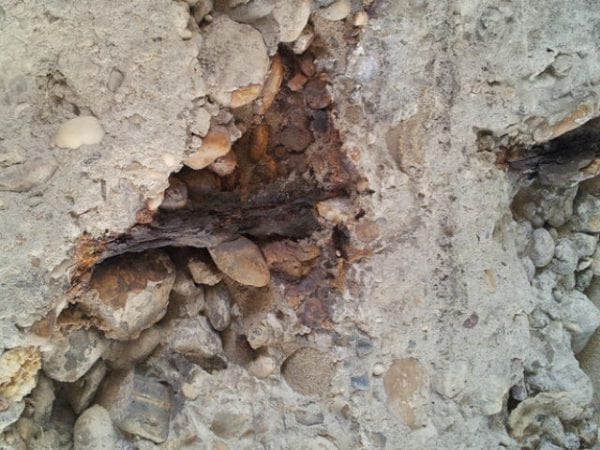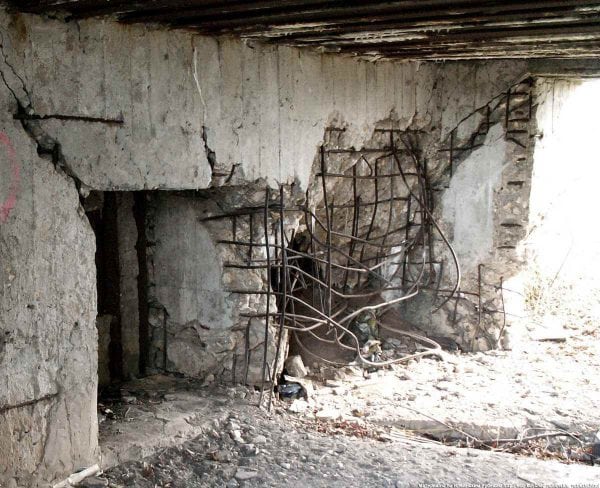Concrete is a very popular artificial material in modern construction, which has excellent strength characteristics. Concrete is made from parts of cement, sand, water and gravel. The material is formed during the solidification of a thick mixture of binders, cement with aggregate. Sand, gravel or gravel may be used as aggregate.
- Types of corrosion
- Component washing
- Corrosion when interacting with acids in water
- Biocorrosion
- The processes of destruction of reinforcement in concrete
- Armature Protection Methods
- Concrete Protection Methods

Currently, concrete is considered the most popular material in modern construction. Corrosion of concrete is a process that often spoils the positive qualities of this material and prevents its full use.
Corrosion of concrete is an irreversible process, during which its structure is destroyed. Under the influence of various environmental factors, as well as from the influence of water, periodic defrosting and freezing, the material becomes brittle and collapses. In addition, corrosion of concrete can occur when the material begins to come into contact with various aggressive materials that are constantly present in the environment.
to contents ↑Types of corrosion
The essence of the corrosion processes in concrete was determined thanks to a number of studies, during which the most effective methods of dealing with fracture processes were found. The main types of concrete corrosion were identified:
- leaching of important structural elements;
- exposure to aggressive substances and acids contained in water;
- biocorrosion.
to contents ↑In addition to the main types of destruction, there is also corrosion of reinforcement in concrete. The essence of this process is best considered separately.
Component washing
This is the most common type of irreversible destruction of concrete. Most of the products from this strong material are operated in open air, and, accordingly, are constantly exposed to atmospheric precipitation and various types of liquid media.
An integral part of the base is calcium hydroxide, which is primarily dissolved under the influence of moisture and water. Calcium hydroxide is gradually destroyed and washed off, changing and destroying the structure of the product.
to contents ↑Corrosion when interacting with acids in water
In the process of exposure to acids, there is an increase in the volume of material or leaching of calcareous compounds of a readily soluble type. This type of destruction occurs due to exposure to a variety of aggressive substances, in the process of contact with which two types of compounds are formed:
- salts;
- amorphous masses.
Salts that are formed during these processes can be easily dissolved and quickly washed out with water. And amorphous masses have absolutely no binding characteristics at all.
Corrosion of acid-type concrete occurs under the influence of any of the acids except polysilicon and hydrofluoric. The occurrence of these acids causes hydroaluminates, hydroferites, hydrosilicates, which during the process of destruction create readily soluble salts and other amorphous masses.
Corrosion of carbon dioxide type concrete is a type of general acid corrosion that occurs due to the effect of water containing free carbon dioxide on concrete. Exceeding the volume of the content of negative carbon dioxide causes the destruction of the previously formed carbonate film.
to contents ↑
Biocorrosion
This type of corrosion occurs when insoluble salts are formed in the pores and capillaries of concrete, the gradual accumulation of which causes compaction of the stone and its subsequent destruction.
In addition, bacteria, fungi and some types of algae can penetrate deep into the cement stone and develop there. The results of their metabolism, which enter the pores and become the cause of the gradual destruction of the stone.
to contents ↑The processes of destruction of reinforcement in concrete
If the reinforced concrete or reinforced concrete is present in the concrete structure, it is possible that another type of spoilage of this material appears, which occurs as a result of the destruction of the reinforcement.
The reinforcement in the middle of the cement stone rusts or the formation of iron corrosion products occurs due to exposure to concrete or the presence of hydrogen sulfide, chlorine and sulfur dioxide in the air. By volume, these materials exceed the original volume, which was set by the reinforced concrete structure, and this, in turn, causes internal stress and, as a result, cracking of concrete.
Air and moisture penetrate into the inner layers of the product to the reinforcement due to the presence of pores in the cement stone. Their supply to the surface is uneven and, for this reason, electrochemical corrosion of the reinforcement may occur in different areas, the flow rate of which depends on the level of moisture permeability and the size of the porosity of the cement stone.
If concrete has been exposed for a long time to air, a thin film of protective film can form on the surface under the influence of carbon dioxide. Such a coating is not soluble in water and is not exposed to salts. This process is called carbonation. It provides corrosion protection for cement stone, but can cause a phenomenon such as corrosion of reinforcement.
Armature Protection Methods
Today, several methods are used, thanks to which the reinforcement is protected from corrosion. Among them are:
- refinement of the surrounding metal environment by using quality varieties of concrete with a special composition or the introduction of inhibitors;
- the use of additional methods for protecting concrete reinforcement from corrosion;
- improvement of the characteristics of the metal used.
Concrete itself is the environment around which metal is surrounded, since it is it that is located around the reinforcement. In order to extend the period of use of reinforcement, you just need to try and improve the effect of concrete stone on steel reinforcement. First of all, it is necessary to exclude or reduce the content of substances in the cement composition that can contribute to the strengthening of destructive processes.
If concrete products are used in conditions of periodic humidity, they must be impregnated with special impregnations of bitumen or petrolatum type, which significantly reduce the permeability of concrete. And if you saturate the concrete stone in this way constantly, then you can minimize all the processes of destruction to a minimum.
to contents ↑Concrete Protection Methods
The primary protection of concrete from corrosion is through the use of a variety of mineral additives that increase its density. This method is the most effective, but you should always remember that its improper use can cause a completely opposite result. Especially for such purposes, stabilizing, plasticizing or water-retaining additives can be used.
It is possible to improve the quality of the operational characteristics of this material through the use of various additives of the chemical type, which can increase the level of its strength.Due to the increase in the latter, the level of penetration of various substances and compounds of an aggressive nature inside concrete structures is reduced.
Secondary protection of cement stone involves the use of special coatings that prevent various aggressive substances from entering its surface. For this, various varnishes and paints or protective mixtures are most often used. An excellent way of secondary protection can be concrete carbonization or additional waterproofing.
Acrylic coatings, varnishes and special paints applied to the concrete surface prevent particles of solid and gaseous type from reaching the surface, which often cause irreversible damage processes. Thanks to such coatings, concrete can be reliably protected from moisture and harmful microorganisms.
No less effective is the method of protecting cement stone with the help of unique mastics, forming a protective barrier on its surface, which protects it from moisture and other solid media.
Biocidal additives of internal and external types protect concrete from the ingress and influence of microorganisms, bacteria and fungi both inside the product and outside.
The most effective method of protecting cement stone from the occurrence of irreversible destructive processes that cause concrete corrosion, experts consider the integrated use of primary and secondary protection. Only an integrated approach will save products and provide them with a long service life.







